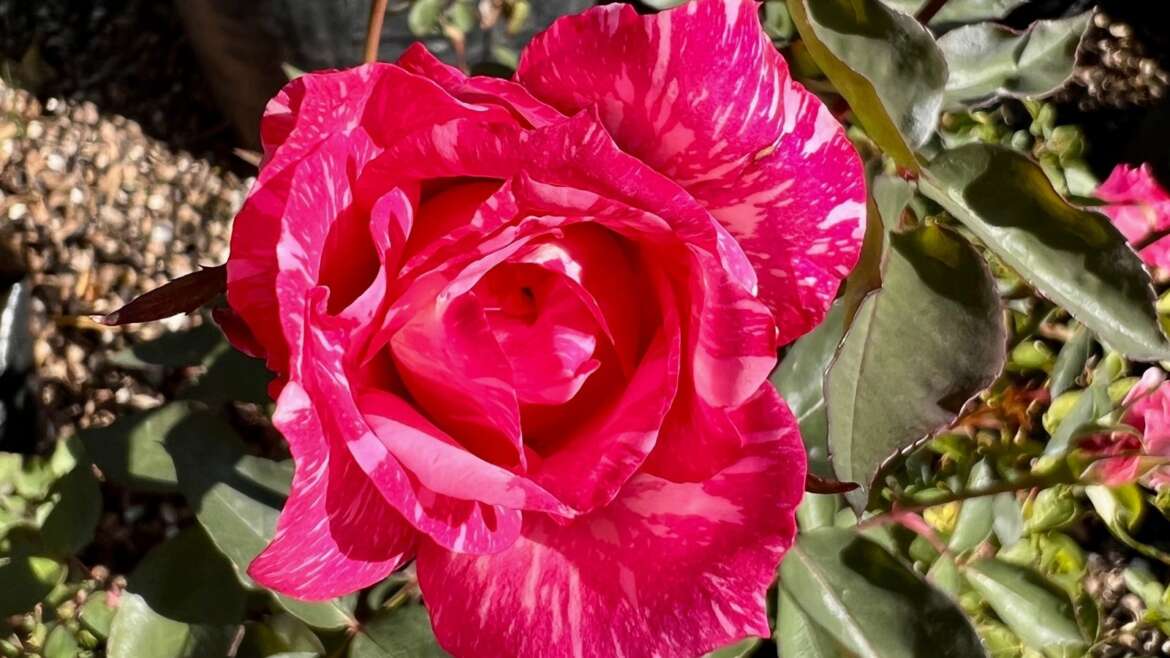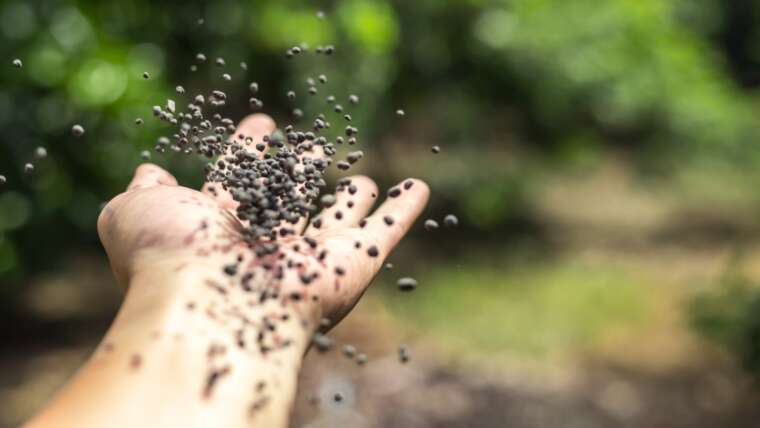Roses, especially old garden roses, bring beauty and romance to the garden in flower, fragrance, and history. The tales an heirloom rose could tell! They’ve traveled, commingled, persevered, and charmed gardens for centuries.
Among the first antique roses to feature the ability to rebloom (rather than once a season in late spring or early summer), Portland, Bourbon, and hybrid perpetual roses changed gardens forever. These classes contain the ancestors of modern roses.
Characterized for repeat flowering, plant health, fragrance, and adaptability, heirloom roses perform beautifully in the contemporary garden. Their parentage in species roses leads to improved disease resistance among many of the historic cultivars. Let’s pay homage to the garden cornerstones of the Portland, Bourbon, and hybrid perpetual roses.
The Short Answer
Portland, Bourbon, and hybrid perpetual roses are heirlooms prized for being the first in repeat flowering in the 18th and 19th centuries. These old garden rose hybrids led to the cultivation of modern roses and remain popular, hardy and adaptable still, with origins in wild rose species. Their abundant blooms, vigor, fragrance, and history charm the garden.
The Long Answer
Antique roses are cherished for their adaptability and exceptional flowering.
Portland roses emerged as crosses of wild roses, both naturally and in cultivation, to create a vigorous repeat-blooming rose. Further cultivation led to Bourbon roses, characterized by large, fragrant flowers, and then to the hybrid perpetuals. Rosarians honed in on flower quality, recurrent blooms, and plant vigor.
Portland, Bourbon, and hybrid perpetuals predate modern roses (cultivated after 1867, when hybrid tea roses surpassed their predecessors in popularity). These cherished antique roses parented the hybrid teas and possess adaptability and exceptional flowering.
Portlands
 The Portland Rose was named after the Duchess of Portland.
The Portland Rose was named after the Duchess of Portland.
Portland roses are old garden varieties that came into being around 1770. Named for the Duchess of Portland, an avid plant collector, the original Portland rose bears her name.
Because of their parentage, Portland roses feature the novel ability to rebloom, incredibly unique in a time when known roses flowered only once a season. By the mid-19th century, Portlands were popular in cottage gardens for their floriferous qualities.
Parentage
 Gallica roses were commercially grown for their beauty and various practical uses.
Gallica roses were commercially grown for their beauty and various practical uses.
The small group of Portland rose hybrids arose from crosses between ‘Autumn Damask’ (the original damask rose) and Rosa gallica, indigenous to central and southern Europe. In cultivation since the 13th century, Gallica roses were grown commercially for their blooms, vigor, and medicinal, culinary, and cosmetic uses (also called “the apothecary rose”). R. gallica ‘Officinalis’ became popular in Victorian gardens and is the ancestor of many other roses like damasks and albas.
Damask roses, the other Portland parent, originated in Central Asia from crossing three wild species: R. gallica, R. moschata (the musk rose), and R. fedtschenkoana. Hybridization likely occurred in cultivation since their habitats don’t overlap. The resulting ‘Autumn Damask’ (or ‘Quatre Saisons’ in France) is prized for its repeat flowering.
Characteristics
 These roses are characterized by vigorous growth and compact size.
These roses are characterized by vigorous growth and compact size.
Portland roses grow vigorously but aren’t unwieldy in size or habit, and none are climbers. Richly fragrant white, pink, red, and purple flowers appear to rest on the foliage, as stems are short between flowers and leaflets.
At the height of cultivation, around 150 Portland rose varieties existed. About 16 are listed today, though more may be classified in the Portland rose lineage.
Portlands play an essential role in modern rose development as parents to hybrid perpetual roses (who then parented hybrid teas). Hybrid perpetuals soon took the place of Portlands.
‘Rose du Roi’
 This rose cultivar is a parent plant of hybrid perpetuals.
This rose cultivar is a parent plant of hybrid perpetuals.
A famed Portland rose from 1815, ‘Rose du Roi’ brings bright red flowers with purple overtones. Fully double blooms repeat prolifically all season with an old rose perfume,
‘Rose du Roi’ boasts the disease resistance of its gallica and damask rose parentage. It is shade-tolerant and grows well in containers. Blooms make excellent, exhibition-worthy cut flower specimens.
‘Rose du Roi,’ one of the earliest cultivars from the first Portland rose (‘Dutchess of Portland’), is thought to be the parent plant of the first (and many) hybrid perpetuals. It remains a favorite among the Portland roses for its vigorous flowering.
‘Duchess of Portland’
 Horticulturists in France and England popularized the ‘Duchess of Portland’ shrub rose.
Horticulturists in France and England popularized the ‘Duchess of Portland’ shrub rose.
Rosa ‘Duchess of Portland,’ the original Portland rose, features bright red blooms, semi-double, with bright yellow stamens. ‘Duchess’ free flowers from summer through fall, and pollinators appreciate the open centers.
‘Duchess of Portland’ circulated in France and England, where horticulturists quickly cultivated it for its unique attributes. The ‘Duchess’ went on to parent popular cultivars in Victorian gardens that eventually led to modern roses.
The ‘Duchess of Portland’ shrub rose is compact but loose and grows between two to four feet tall and three feet wide with an upright, spreading habit.
‘Comte de Chambord’
 This highly fragrant antique rose is prized for its deep pink double flowers.
This highly fragrant antique rose is prized for its deep pink double flowers.
‘Comte de Chambord’ lends an abundant look to the rose bush in flower and foliage. As Portland roses “rest” on their leaves due to short stems, the result is a full, leafy plant bursting with blooms.
The 1863 ‘Comte de Chambord’ features deep pink double flowers tinged in lilac. Full and flat blooms bear a spicy, old-world rose fragrance. Plants reach four feet tall and three feet wide with an upright habit.
Growers maintain this is one of the best antique roses in fragrance and repeat flowering. It’s a good option for beginners delving into the world of heirlooms.
Bourbons
 These roses originated from a natural cross between wild roses near Mauritius and Madagascar.
These roses originated from a natural cross between wild roses near Mauritius and Madagascar.
On an island in the Indian Ocean, wild roses naturally cross-pollinated to create a new type of rose (the origin of modern types). Bourbon roses represent a group of old garden rose hybrids from a natural cross between wild species on the Île de Bourbon (now Reunion) near Mauritius and off Madagascar.
Parentage
On the island, a lineage of ‘Autumn Damask’ hybridized with a China rose around 1817. The Damask and China rose parents of Bourbon roses account for their heavenly fragrance and continual blooming.
Bourbons share the damask ancestry with Portlands. Their other parent, Rosa chinensis, is a vigorous climber native to China. ‘Old Blush’ became an important repeat-flowering China rose as it flowers continuously and is the foundation for many repeat-blooming rose cultivars.
The new Bourbons made their way to France two years later, where they went on to produce more hybrids and, eventually, modern roses.
Characteristics
 Bourbon roses produce fragrant flowers ranging from creamy white to pink to crimson.
Bourbon roses produce fragrant flowers ranging from creamy white to pink to crimson.
Bourbon roses grow vigorously with good disease resistance and hardy stock. They include climbers and shrub-types with fragrant flowers in creamy white to pink to crimson.
Bourbons usually flush singly or clusters in spring, with repeat flowering throughout the season until frost. Fall may see another bloom flush.
‘Souvenir de la Malmaison’
 This Bourbon rose is susceptible to drooping in heavy rain.
This Bourbon rose is susceptible to drooping in heavy rain.
A gorgeous Bourbon rose introduced in 1843, ‘Souvenir de la Malmaison’ boasts large, cupped blooms and high fragrance. Flowers with the prettiest shade of soft ballet pink hold more than 70 petals and open flat and quartered. Blooms recur from spring through fall.
‘Souvenir’ remains a favorite old garden rose, an award winner prized by rosarians as perhaps the best of the Bourbons. Large, leathery foliage makes a handsome backdrop, and showy rose hips emerge in fall. Look for the climbing variety to make a pretty vertical element.
‘Souvenir de la Malmaison’ is a vigorous, nearly thornless, hardy, and disease-resistant rose. Once established, it tolerates heat and periods of drought. ‘Souvenir’s’ only price to bear is that with such large blooms, heavy rain may impact the flowers, causing them to droop or fall.
‘Zephirine Drouhin’
 The ‘Zephirine Drouhin’ is ideal for training along structures for a striking garden feature.
The ‘Zephirine Drouhin’ is ideal for training along structures for a striking garden feature.
A gorgeous, time-tested climbing rose, the heirloom ‘Zephirine Drouhin’ shines in bloom color, size, and fragrance. Deep pinkish-red blooms perfume the garden with raspberry notes in spring and fall. This climber blooms all summer but is more prolific when temperatures are cool.
‘Zephirine Drouhin’ is an adaptable rose that thrives in full sun to partial shade and tolerates poor soils. While susceptible to black spot and mildew diseases, the plant continues to grow and bloom through frost. As with other roses, avoid overhead watering, water in the morning, provide good air circulation, and grow in full sunlight for best disease resistance.
Continual flushes of fragrant flowers and a tall, vigorous habit make ‘Zephirine’ a prize. Train it along a wall, archway, or pergola for a big impact.
‘Louise Odier’
 The ‘Louise Odier’ rose exhibits vigorous growth with abundant blooms.
The ‘Louise Odier’ rose exhibits vigorous growth with abundant blooms.
Another prized Bourbon rose, ‘Louise Odier’ graces the garden with rich pink domed blooms that repeat all season. The luscious, double flowers resemble camellias and carry a strong, fruity fragrance.
Bred in 1851, ‘Louise Odier’ is vigorous but well-behaved with a rounded habit. Thick stems with prickles hold the numerous, continual blooms. ‘Louise Odier’ tolerates partial shade (with at least four hours of sunlight for best growth).
Hybrid Perpetuals
 Exhibition-worthy blooms popularized these roses during the Victorian era,
Exhibition-worthy blooms popularized these roses during the Victorian era,
Hybrid perpetuals became the next generation of Bourbons, prized for their exhibition-worthy flowers and plant vigor. In Victorian gardens, hybrid perpetuals were must-haves, with nearly 4,000 hybrids in cultivation by 1900. Hybrid perpetuals led to the development of the hybrid tea rose, and with their introduction in 1867, the hybrid teas took over with florist-perfect blooms.
Parentage
Hybrid perpetuals emerged during the late 1800s through crosses of Portland, Bourbon, and Gallica roses. They represent the best of their ancestors, honing in on fragrance, prolific flowering, and form.
Characteristics
 Hybrid perpetuals are prized for their vigorous growth and hardiness.
Hybrid perpetuals are prized for their vigorous growth and hardiness.
Most hybrid perpetuals feature large, sweetly fragranced blooms in shades of pink or red. Long, arching stems led to the practice of “pegging” stems horizontally. Pegging down stems allows new buds to emerge along the length of the stem, leading to more flowers.
These varieties boast vigorous growth, hardiness, recurring blooms, and showy flowers. They make excellent cut flowers.
‘Reine des Violettes’
 A hybrid perpetual rose called ‘Reine des Violettes’ stands out for its exquisite fragrance.
A hybrid perpetual rose called ‘Reine des Violettes’ stands out for its exquisite fragrance.
‘Reine des Violettes’ is a stunning hybrid perpetual old garden rose with lilac purple, fully double blooms. Large, cupped flowers hold over 60 petals and open flat as quartered rosettes. The violet blooms contrast with gray-green foliage beautifully.
‘Reine des Violettes’ features uniqueness in its hues of purple (fading to deep violet, as near blue as roses get), in flower size at four to five inches, and its supreme scent. Its exceptional fragrance drifts through the garden or fills a room if in a vase.
‘Reine des Violettes’ thrives with characteristic hybrid perpetual adaptability. Thick stems are nearly thornless. This 1860’s rose deserves a spot in your heirloom rose garden, brimming with old-world charm.
‘Dupuy Jamain’
 The ‘Dupuy Jamain’ rose variety exhibits large, four to five-inch flowers in florist-rose form.
The ‘Dupuy Jamain’ rose variety exhibits large, four to five-inch flowers in florist-rose form.
‘Dupuy Jamain’, bred in 1868 and named for one of Paris’s most esteemed horticultural houses, features large, high-centered cerise blooms. The pink-red flowers characterize the hybrid perpetual, loaded with velvety petals and fragrance.
Like most hybrid perpetuals, strong, nearly thornless canes hold lots of leaves in an upright, bushy habit. A profusion of blooms appear in late spring and early summer and repeat until frost.
‘Dupuy Jamain’ represents characteristics of modern roses with large, four to five-inch flowers in florist-rose form. Flowers cover the bush for a showstopping heirloom specimen.
‘Madame Victor Verdier’
 This historic rose variety is a parent to the first hybrid tea rose, ‘La France’.
This historic rose variety is a parent to the first hybrid tea rose, ‘La France’.
‘Madame Victor Verdier’ is a rose right out of antique botanical illustrations. Full-petaled flowers repeat bloom in brilliant red with pink tones.
Cupped, double blooms carry a high fragrance. Thick stems are nearly thornless, with ample foliage for a full rose shrub.
‘Madame Victor Verdier’ holds her place in history as a parent to the first hybrid tea rose, ‘La France.’ ‘La France’ features the high-centered blooms that characterize hybrid teas.
Final Thoughts
Portland, Bourbon, and hybrid perpetual old garden roses yield important signature cultivars with the best attributes of vigor, flowering, fragrance, and adaptability. These heirlooms offer looser, leafier plants with robust growth and a profusion of blooms.
The full-petaled blooms, cupped or domed, in rich colors are as valuable in today’s garden as they were centuries ago. Celebrate their beauty and history and add a little drama to your garden with an heirloom rose.




